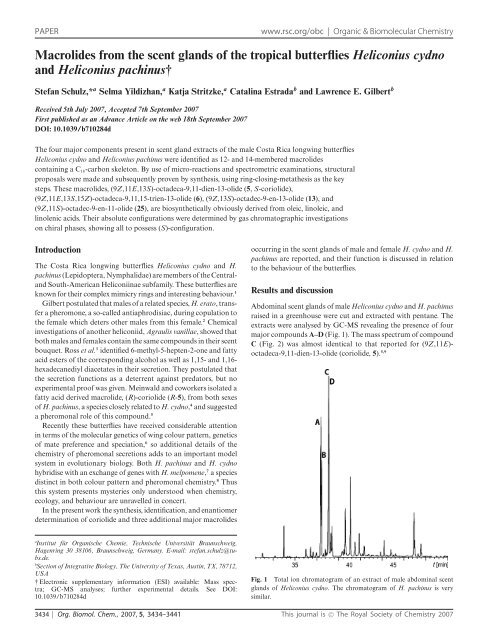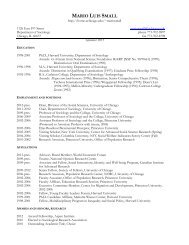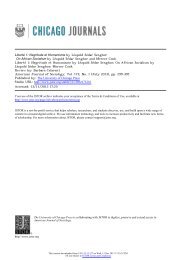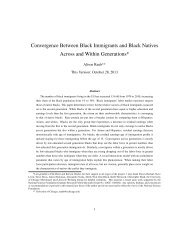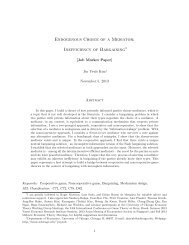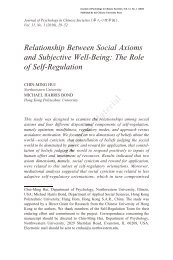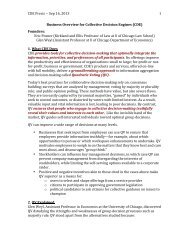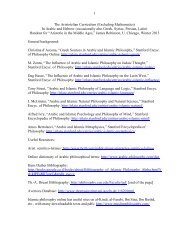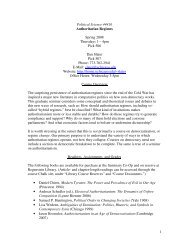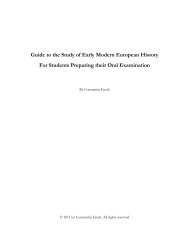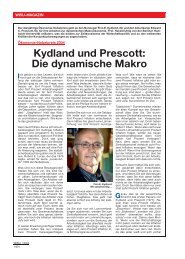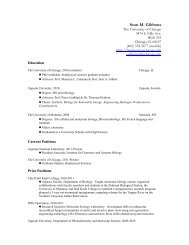Macrolides from the scent glands of the tropical butterflies ...
Macrolides from the scent glands of the tropical butterflies ...
Macrolides from the scent glands of the tropical butterflies ...
You also want an ePaper? Increase the reach of your titles
YUMPU automatically turns print PDFs into web optimized ePapers that Google loves.
PAPER www.rsc.org/obc | Organic & Biomolecular Chemistry<br />
<strong>Macrolides</strong> <strong>from</strong> <strong>the</strong> <strong>scent</strong> <strong>glands</strong> <strong>of</strong> <strong>the</strong> <strong>tropical</strong> <strong>butterflies</strong> Heliconius cydno<br />
and Heliconius pachinus†<br />
Stefan Schulz,* a Selma Yildizhan, a Katja Stritzke, a Catalina Estrada b and Lawrence E. Gilbert b<br />
Received 5th July 2007, Accepted 7th September 2007<br />
First published as an Advance Article on <strong>the</strong> web 18th September 2007<br />
DOI: 10.1039/b710284d<br />
The four major components present in <strong>scent</strong> gland extracts <strong>of</strong> <strong>the</strong> male Costa Rica longwing <strong>butterflies</strong><br />
Heliconius cydno and Heliconius pachinus were identified as 12- and 14-membered macrolides<br />
containing a C 18-carbon skeleton. By use <strong>of</strong> micro-reactions and spectrometric examinations, structural<br />
proposals were made and subsequently proven by syn<strong>the</strong>sis, using ring-closing-meta<strong>the</strong>sis as <strong>the</strong> key<br />
steps. These macrolides, (9Z,11E,13S)-octadeca-9,11-dien-13-olide (5, S-coriolide),<br />
(9Z,11E,13S,15Z)-octadeca-9,11,15-trien-13-olide (6), (9Z,13S)-octadec-9-en-13-olide (13), and<br />
(9Z,11S)-octadec-9-en-11-olide (25), are biosyn<strong>the</strong>tically obviously derived <strong>from</strong> oleic, linoleic, and<br />
linolenic acids. Their absolute configurations were determined by gas chromatographic investigations<br />
on chiral phases, showing all to possess (S)-configuration.<br />
Introduction<br />
The Costa Rica longwing <strong>butterflies</strong> Heliconius cydno and H.<br />
pachinus (Lepidoptera, Nymphalidae) are members <strong>of</strong> <strong>the</strong> Centraland<br />
South-American Heliconiinae subfamily. These <strong>butterflies</strong> are<br />
known for <strong>the</strong>ir complex mimicry rings and interesting behaviour. 1<br />
Gilbert postulated that males <strong>of</strong> a related species, H. erato,transfer<br />
a pheromone, a so-called antiaphrodisiac, during copulation to<br />
<strong>the</strong> female which deters o<strong>the</strong>r males <strong>from</strong> this female. 2 Chemical<br />
investigations <strong>of</strong> ano<strong>the</strong>r heliconiid, Agraulis vanillae, showed that<br />
both males and females contain <strong>the</strong> same compounds in <strong>the</strong>ir <strong>scent</strong><br />
bouquet. Ross et al. 3 identified 6-methyl-5-hepten-2-one and fatty<br />
acid esters <strong>of</strong> <strong>the</strong> corresponding alcohol as well as 1,15- and 1,16hexadecanediyl<br />
diacetates in <strong>the</strong>ir secretion. They postulated that<br />
<strong>the</strong> secretion functions as a deterrent against predators, but no<br />
experimental pro<strong>of</strong> was given. Meinwald and coworkers isolated a<br />
fatty acid derived macrolide, (R)-coriolide (R-5), <strong>from</strong> both sexes<br />
<strong>of</strong> H. pachinus, a species closely related to H. cydno, 4 and suggested<br />
a pheromonal role <strong>of</strong> this compound. 5<br />
Recently <strong>the</strong>se <strong>butterflies</strong> have received considerable attention<br />
in terms <strong>of</strong> <strong>the</strong> molecular genetics <strong>of</strong> wing colour pattern, genetics<br />
<strong>of</strong> mate preference and speciation, 6 so additional details <strong>of</strong> <strong>the</strong><br />
chemistry <strong>of</strong> pheromonal secretions adds to an important model<br />
system in evolutionary biology. Both H. pachinus and H. cydno<br />
hybridise with an exchange <strong>of</strong> genes with H. melpomene, 7 a species<br />
distinct in both colour pattern and pheromonal chemistry. 8 Thus<br />
this system presents mysteries only understood when chemistry,<br />
ecology, and behaviour are unravelled in concert.<br />
In <strong>the</strong> present work <strong>the</strong> syn<strong>the</strong>sis, identification, and enantiomer<br />
determination <strong>of</strong> coriolide and three additional major macrolides<br />
aInstitut für Organische Chemie, Technische Universität Braunschweig,<br />
Hagenring 30 38106, Braunschweig, Germany. E-mail: stefan.schulz@tubs.de.<br />
bSection <strong>of</strong> Integrative Biology, The University <strong>of</strong> Texas, Austin, TX, 78712,<br />
USA<br />
† Electronic supplementary information (ESI) available: Mass spectra;<br />
GC-MS analyses; fur<strong>the</strong>r experimental details. See DOI:<br />
10.1039/b710284d<br />
occurring in <strong>the</strong> <strong>scent</strong> <strong>glands</strong> <strong>of</strong> male and female H. cydno and H.<br />
pachinus are reported, and <strong>the</strong>ir function is discussed in relation<br />
to <strong>the</strong> behaviour <strong>of</strong> <strong>the</strong> <strong>butterflies</strong>.<br />
Results and discussion<br />
Abdominal <strong>scent</strong> <strong>glands</strong> <strong>of</strong> male Heliconius cydno and H. pachinus<br />
raised in a greenhouse were cut and extracted with pentane. The<br />
extracts were analysed by GC-MS revealing <strong>the</strong> presence <strong>of</strong> four<br />
major compounds A–D (Fig. 1). The mass spectrum <strong>of</strong> compound<br />
C (Fig. 2) was almost identical to that reported for (9Z,11E)octadeca-9,11-dien-13-olide<br />
(coriolide, 5). 5,9<br />
Fig. 1 Total ion chromatogram <strong>of</strong> an extract <strong>of</strong> male abdominal <strong>scent</strong><br />
<strong>glands</strong> <strong>of</strong> Heliconius cydno. The chromatogram <strong>of</strong> H. pachinus is very<br />
similar.<br />
3434 | Org. Biomol. Chem., 2007, 5, 3434–3441 This journal is © The Royal Society <strong>of</strong> Chemistry 2007
Fig. 2 Mass spectra <strong>of</strong> compounds A ((Z)-octadec-9-en-11-olide,<br />
Z-25), B ((Z)-octadec-9-en-13-olide, 13), C ((9Z,11E)-octadeca-9,11dien-13-olide,<br />
coriolide, 5), and D ((9Z,11E,15Z)-octadeca-9,11,15-trien-<br />
13-olide, 6).<br />
The o<strong>the</strong>r three compounds exhibited similar mass spectra,<br />
but with different molecular ions. Compounds A and B had a<br />
molecular mass 2 amu higher than that <strong>of</strong> C, suggesting <strong>the</strong>se<br />
to be two octadecenolides, while compound D had a molecular<br />
mass 2 amu less than that <strong>of</strong> C and was <strong>the</strong>refore believed to<br />
be an octadecatrienolide. The mass spectrum <strong>of</strong> 5 showed a<br />
characteristic ion at m/z 207 (M − 71), which can be attributed to<br />
<strong>the</strong> loss <strong>of</strong> <strong>the</strong> pentyl side chain. This ion occurs also prominently<br />
in <strong>the</strong> spectrum <strong>of</strong> compound D, in which case it corresponds to<br />
<strong>the</strong> loss <strong>of</strong> a pentenyl side chain (M − 69). Compound B showed<br />
a small ion at m/z 209, which could be interpreted as a loss <strong>of</strong> a<br />
pentyl side chain. In contrast, <strong>the</strong> mass spectrum <strong>of</strong> compound A<br />
contained an intense ion at m/z 181 (M − 99) pointing to a heptyl<br />
side chain. Hydrogenation <strong>of</strong> an extract with Pd/C furnished two<br />
saturated macrolides E and F (for mass spectra see ESI†). The main<br />
one E was identified as 13-octadecanolide by its characteristic ion<br />
at m/z 211 (M − 71), while <strong>the</strong> minor one showed a peak at m/z<br />
183 (M − 99), consistent with 11-octadecanolide. Biosyn<strong>the</strong>tically,<br />
coriolide is certainly derived <strong>from</strong> linoleic acid by oxidation<br />
at C-13 with concomitant double bond migration, followed by<br />
ring closure. A similar mechanism starting with linolenic acid<br />
wouldleadto(9Z,11E,15Z)-octadeca-9,11,15-trien-13-olide, <strong>the</strong><br />
putative structure <strong>of</strong> compound D. Compounds A and B are<br />
most likely derived <strong>from</strong> oleic acid, but a different precursor like<br />
vaccenic acid seemed also to be plausible.<br />
We <strong>the</strong>refore tried to elucidate <strong>the</strong> position <strong>of</strong> <strong>the</strong> double bond<br />
in both octadecenolides by addition <strong>of</strong> dimethyldisulfide (DMDS)<br />
to <strong>the</strong> extract, followed by GC-MS analysis. 10,11 Surprisingly, <strong>the</strong><br />
adducts showed largely different mass spectra (Fig. 3). The adduct<br />
<strong>of</strong> A exhibited an intensive cluster <strong>of</strong> peaks around m/z 171. This<br />
can be explained by elimination <strong>of</strong> <strong>the</strong> ester group <strong>from</strong> <strong>the</strong> chain<br />
and additional loss or transfer <strong>of</strong> hydrogen. When <strong>the</strong> double bond<br />
is located at C-9, cleavage between <strong>the</strong> two thiomethyl groups leads<br />
to such ions carrying <strong>the</strong> alkyl end <strong>of</strong> <strong>the</strong> molecule. The o<strong>the</strong>r<br />
cleavage product carrying <strong>the</strong> carboxyl end is also present at m/z<br />
203. Ions at m/z 171 and 203 can be found in <strong>the</strong> spectrum <strong>of</strong> <strong>the</strong><br />
second adduct, too, but only <strong>of</strong> relatively low abundance. Instead,<br />
ions at m/z 122 and 136 dominate. They can be explained by<br />
additional losses <strong>of</strong> CH 3SH, H 2O,andH<strong>from</strong>m/z 171 or 203, as<br />
shown in Fig. 3. These results pointed towards <strong>the</strong> location <strong>of</strong> <strong>the</strong><br />
double bond at C-9 in both compounds, but o<strong>the</strong>r positions could<br />
not be completely ruled out by <strong>the</strong> derivatisation results.<br />
The macrolides A–D were <strong>the</strong>n syn<strong>the</strong>sised to prove our<br />
structural assignments, to elucidate <strong>the</strong>ir absolute configuration,<br />
and provide material for biotests. (S)-Coriolide (5) has been syn<strong>the</strong>sised<br />
before using <strong>the</strong> enzymatic oxidation <strong>of</strong> linoleic acid (2)<br />
with soy bean lipoxygenase, reduction and macrolactonisation, 12,13<br />
while a similar reaction with linolenic acid (1) leading to<br />
octadeca-9,11,15-trien-13-olide (6) was described in a patent. 14<br />
We followed this route using both 2 and 1 as starting materials.<br />
The oxidation with soy bean lipoxygenase at C-13 proceeds<br />
with concomitant double bond migration and is known to<br />
furnish <strong>the</strong> S-configured hydroperoxide. 15,16 Reductive work-up<br />
with NaBH 4 15 delivers <strong>the</strong> corresponding acids (9Z,11E,13S)-<br />
13-hydroxyoctadeca-9,11-dienoic acid (coriolic acid, 3) and<br />
(9Z,11E,13S,15Z)-13-hydroxyoctadeca-9,11,15-trienoic acid (4).<br />
Cyclisation worked best in our hands using Corey/Nicolaou<br />
conditions 13 to furnish S-5 and S-6 (Fig. 4). Both macrolides<br />
were generated in high ee (>95%), but only moderate yield.<br />
Never<strong>the</strong>less, <strong>the</strong> target molecules are obtained in two steps only,<br />
making this route very attractive for this class <strong>of</strong> compounds.<br />
The two macrolides were identical to <strong>the</strong> natural compounds,<br />
thus confirming our structural assignments for C and D. Nonracemic<br />
mixtures <strong>of</strong> <strong>the</strong>ir enantiomers were <strong>the</strong>n needed for<br />
<strong>the</strong> determination <strong>of</strong> <strong>the</strong> absolute configuration <strong>of</strong> <strong>the</strong> natural<br />
compounds. They were syn<strong>the</strong>sised by inversion <strong>of</strong> S-3 and S-4 by<br />
<strong>the</strong> Mitsunobu procedure, followed by macrolactonisation.<br />
Gas chromatographic analysis <strong>of</strong> <strong>the</strong> syn<strong>the</strong>tic macrolides 5 and<br />
6 and a crude <strong>scent</strong> gland extracts <strong>of</strong> Heliconius cydno and Heliconius<br />
pachinus on a chiral Hydrodex (2,3-di-O-methyl-6-TBDMSb-cyclodextrin)<br />
phase showed that both natural macrolides are<br />
enantiomerically pure and possess S-configuration (Fig. 5).<br />
Therefore, compound C is (9Z,11E,13S)-octadeca-9,11-dien-13olide<br />
(S-5, coriolide), while <strong>the</strong> structure <strong>of</strong> compound D is<br />
(9Z,11E,13S,15Z)-octadeca-9,11,15-trien-13-olide (S-6).<br />
Our attention <strong>the</strong>n turned towards <strong>the</strong> syn<strong>the</strong>sis <strong>of</strong> <strong>the</strong> two<br />
octadecenolides A and B. Attempts to apply <strong>the</strong> soy bean<br />
lipoxygenase reaction to oleic acid for syn<strong>the</strong>sis <strong>of</strong> <strong>the</strong> two compounds<br />
failed. Therefore we switched to a syn<strong>the</strong>tic route using<br />
This journal is © The Royal Society <strong>of</strong> Chemistry 2007 Org. Biomol. Chem., 2007, 5, 3434–3441 | 3435
Fig. 3 Mass spectra and fragmentation pattern <strong>of</strong> DMDS-adducts<br />
derived <strong>from</strong> A and <strong>from</strong> B.<br />
ring-closing-meta<strong>the</strong>sis (RCM) as <strong>the</strong> key step. The Grignard<br />
reaction <strong>of</strong> hexanal (7) and 1-bromo-3-butene furnished dec-1en-5-ol<br />
9, which was acylated with 9-decenoic acid (11), generated<br />
<strong>from</strong> 9-decen-1-ol (10). The resulting ester rac-12 was <strong>the</strong>n submitted<br />
to RCM using <strong>the</strong> Grubbs ′ catalyst <strong>of</strong> <strong>the</strong> first generation<br />
(Fig. 6). rac-Octadec-9-en-13-olide (13) was obtained in good<br />
Fig. 4 Syn<strong>the</strong>sis <strong>of</strong> coriolide ((S)-5) and(S)-6: a) soybean lipoxygenase,<br />
O 2,b)NaBH 4, c) PPh 3,(C 5H 5NS) 2.<br />
Fig. 5 GC investigation <strong>of</strong> coriolide 5 (A, ion trace 278) and <strong>of</strong><br />
octadecatrienolide (6, B,iontracem/z 276) on a chiral stationary phase<br />
(Hydrodex, 15 m, 150 ◦ C, 0.2 ◦ Cmin −1 to 200 ◦ C). The following samples<br />
were analysed (<strong>from</strong> top to bottom): crude <strong>scent</strong> gland extract <strong>of</strong> H. cydno,<br />
co-injection <strong>scent</strong> gland extract and syn<strong>the</strong>tic (R/S) mixture, syn<strong>the</strong>tic<br />
(S) compounds, and (R/S) mixture. The analysis <strong>of</strong> H. pachinus showed<br />
identical results.<br />
yield, surprisingly showing a 9 : 1 Z : E ratio in contrast to <strong>the</strong><br />
E-preference <strong>of</strong>ten found in RCM. 17 The preference for <strong>the</strong> Zisomer,<br />
identical to compound B, was verified by NMR analysis<br />
using NOESY spectra.<br />
The configuration <strong>of</strong> B was <strong>the</strong>n clarified by syn<strong>the</strong>sis <strong>of</strong> pure<br />
enantiomers. Alkyne RCM 18 allowed a simple entry towards<br />
diastereomerically and enantiomerically pure products (Fig. 7),<br />
starting with 5-hexynoic acid (14). This acid was isomerised into 4hexynoic<br />
acid 19 and transformed into <strong>the</strong> aldehyde 15. Dipentylzinc<br />
was <strong>the</strong>n used in an enantioselective alkylation according<br />
to Kobayashi et al. 20 using (1R,2R)-1,2-N,N ′ -bis(p-toluenesulfonylamino)cyclohexane<br />
as ligand for <strong>the</strong> chiral titanium catalyst.<br />
The zinc reagent always attacks <strong>from</strong> <strong>the</strong> Re-side when this<br />
3436 | Org. Biomol. Chem., 2007, 5, 3434–3441 This journal is © The Royal Society <strong>of</strong> Chemistry 2007
Fig. 6 Syn<strong>the</strong>sis <strong>of</strong> rac-octadec-9-en-13-olide (13): a) PDC, DMF, b) SOCl 2, c) bis(tricyclohexylphosphane)benzylidene ru<strong>the</strong>nium(IV) dichloride,<br />
CH 2Cl 2.<br />
Fig. 7 Syn<strong>the</strong>sis <strong>of</strong> (9S)-octadec-9-en-13-olide (S-13): a) KOtBu, b) DIBAL, c) Zn(C 5H 11) 2,(1R,2R)-(TsNH) 2C 6H 10, Ti(OiPr) 4,d)SOCl 2,e)Mo(CO) 6,<br />
4-Cl-Ph-OH, f) Lindlar cat., H 2, g) [Cp*Ru(MeCN) 3]PF 6, HSi(OEt) 3,CH 2Cl 2,P(CH 2OH) 3, h) AgF, MeOH.<br />
ligand is used, producing <strong>the</strong> alcohol (S)-undec-2-yn-6-ol (16) in<br />
moderate yield, but excellent ee (98%). Esterification with undec-9ynoic<br />
acid (18), which was obtained by isomerisation <strong>from</strong> undec-<br />
10-ynoic acid (17), 19 gave <strong>the</strong> diynoate 19. Thisprecursorwas<br />
submitted to alkyne RCM with Mo(CO) 6 and p-chlorophenol in<br />
chlorobenzene, 18 furnishing octadec-9-yn-13-olide (S-20) in good<br />
yield. The cyclic alkyne was finally hydrogenated under Lindlar<br />
catalysis to deliver <strong>the</strong> pure Z,S-configured macrolide Z,S-13 with<br />
an ee <strong>of</strong> 98%. The opposite (R)-enantiomer was obtained by a<br />
similar sequence using <strong>the</strong> (S,S)-cyclohexanediamine derivative as<br />
ligand in <strong>the</strong> asymmetric alkylation reaction. Attempts to obtain<br />
pure (E)-13 <strong>from</strong> 20 by hydrosilylation according to Fürstner<br />
et al. 21 were only partly successful, leading to a 44 : 56 E :<br />
Z mixture under non-optimised conditions. Never<strong>the</strong>less, this<br />
mixture proved to be very useful in <strong>the</strong> determination <strong>of</strong> <strong>the</strong> double<br />
bond geometry <strong>of</strong> <strong>the</strong> natural product.<br />
Finally, <strong>the</strong> enantiomers <strong>of</strong> 13 were separated on a chiral<br />
cyclodextrin phase, showing that <strong>the</strong> natural compound possesses<br />
This journal is © The Royal Society <strong>of</strong> Chemistry 2007 Org. Biomol. Chem., 2007, 5, 3434–3441 | 3437
exclusively S-configuration (see ESI†). It follows that B is<br />
(9Z,13S)-octadec-9-en-13-olide (S,Z-7).<br />
Compound A was proposed to be octadec-9-en-11-olide (25)<br />
and syn<strong>the</strong>sised via alkene RCM starting <strong>from</strong> octanal and<br />
vinylmagnesium bromide. The resulting dec-1-en-3-ol (23) was<br />
acylated with 9-decenoic acid and <strong>the</strong> resulting ester 24 submitted<br />
to RCM. In this case an 88 : 12 E : Z mixture <strong>of</strong> 25 was<br />
obtained and <strong>the</strong> structure <strong>of</strong> A confirmed to correspond to<br />
<strong>the</strong> Z-isomer. An enantioselective syn<strong>the</strong>sis <strong>of</strong> 25 was <strong>the</strong>n<br />
accomplished (Fig. 8). Reaction <strong>of</strong> octanoyl chloride (21) with<br />
ethynyltrimethylsilane gave dec-1-yn-3-one 22. This ketone was<br />
enantioselectively reduced with LiAlH 4 in<strong>the</strong>presence<strong>of</strong>Nmethyl<br />
ephedrine 22 to yield (S)-dec-1-yn-3-ol with moderate ee<br />
(67%). Reduction with LiAlH 4 furnished <strong>the</strong> decenol S-23,which<br />
was acylated as described to form S-24. Finally, RCM gave an<br />
88 : 12-mixture <strong>of</strong> (9E,11S)-octadec-9-en-11-olide (E,S-25) and<br />
(9Z,11S)-octadec-9-en-11-olide (Z,S-25) with an ee <strong>of</strong> 67% in both<br />
cases, showing <strong>the</strong> expected E preference.<br />
Attempts to syn<strong>the</strong>sise pure Z-25 by alkyne meta<strong>the</strong>sis using<br />
<strong>the</strong> Mo(CO) 6 and p-chlorophenol system resulted in complete<br />
product decomposition. The failure may be explained by <strong>the</strong> close<br />
proximity <strong>of</strong> <strong>the</strong> ester group and <strong>the</strong> triple bond in <strong>the</strong> precursor<br />
which may lead to interaction with <strong>the</strong> catalyst with an undesired<br />
outcome.<br />
Comparison with <strong>the</strong> natural compound A using gas chromatography<br />
with a 2,6-di-O-methyl-3-O-pentyl-b-cyclodextrin<br />
phase 23 revealed that <strong>the</strong> (9Z,11S)-25 enantiomer occurs naturally.<br />
The three macrolides 6, 13, and25 are new natural products,<br />
while S-coriolide 5 has been found previously in <strong>the</strong> seed oil <strong>of</strong><br />
Monnina emarginata 9 and <strong>the</strong> fungus Stagonospora. 24 In a previous<br />
investigation 5 Meinwald et al. isolated 5 <strong>from</strong> male H. pachinus<br />
and determined its absolute configuration by optical rotatory<br />
dispersion and comparison with an au<strong>the</strong>ntic sample <strong>of</strong> <strong>the</strong> Senantiomer<br />
obtained <strong>from</strong> M. emarginata as R-5. Nospecific<br />
rotation was reported. In contrast, <strong>the</strong> coriolides produced by both<br />
H. pachinus and H. cydno investigated by us are S-configured.<br />
This assignment is unambiguous, because <strong>the</strong> optical rotation<br />
<strong>of</strong> <strong>the</strong> syn<strong>the</strong>sised pure compound exhibits <strong>the</strong> same sense <strong>of</strong><br />
rotation as reported 9,12 and <strong>the</strong> soy bean lipoxygenase is known<br />
to produce S-configured hydroperoxides. The agreement between<br />
natural and syn<strong>the</strong>sised compounds was proven by chiral GC-<br />
MS. One explanation <strong>of</strong> <strong>the</strong> discrepancy in <strong>the</strong> results obtained by<br />
Meinwald et al. and ours may be that <strong>the</strong> <strong>butterflies</strong>, originating<br />
<strong>from</strong> different sources, produced different enantiomers, or that <strong>the</strong><br />
sample isolated by Meinwald et al. was not pure.<br />
All natural macrolides are obviously derived <strong>from</strong> oleic, linoleic,<br />
and linolenic acids, formed by oxidation at different positions<br />
and ring closure. They all exhibit <strong>the</strong> same S-configuration. A<br />
minor component in <strong>the</strong> secretion is ricinollactone ((Z)-octadec-<br />
9-en-12-olide), showing that oxidation occurs in case <strong>of</strong> <strong>the</strong><br />
octadecenolides at <strong>the</strong> a-, b-, and c-positions relative to <strong>the</strong> double<br />
bond <strong>of</strong> oleic acid.<br />
The identified macrolides might play a role in <strong>the</strong> chemical<br />
communication system <strong>of</strong> H. cydno and H. pachinus. Females<br />
contain a similar bouquet as <strong>the</strong> males, albeit in markedly<br />
lower concentration. Investigation <strong>of</strong> females before and after<br />
copulation showed that <strong>the</strong>se lactones are produced by <strong>the</strong><br />
males and transferred during copulation. Gilbert postulated that<br />
<strong>the</strong> transferred compounds generally act as antiaphrodisiacs in<br />
Heliconius, protecting <strong>the</strong> fertilised female <strong>from</strong> additional male<br />
courtship attempts. 2 This mechanism was recently investigated by<br />
us in more detail in H. melpomene. 8 In this case (E)-b-ocimene is<br />
transferred toge<strong>the</strong>r with a matrix consisting <strong>of</strong> fatty acid esters.<br />
While <strong>the</strong> esters modulate <strong>the</strong> evaporation rate, ocimene, <strong>the</strong><br />
major component <strong>of</strong> <strong>the</strong> <strong>scent</strong> <strong>glands</strong>, inhibits additional courtship<br />
attempts <strong>of</strong> males on fertilised females. It may well be that <strong>the</strong><br />
macrolides, so far not found in o<strong>the</strong>r Heliconius sp. investigated<br />
by us or o<strong>the</strong>rs, 3,5,8 serve this function, especially because no major<br />
component o<strong>the</strong>r than <strong>the</strong> macrolides was present in <strong>the</strong> <strong>glands</strong>. A<br />
defensive role, proposed for <strong>the</strong> compounds identified in <strong>the</strong> same<br />
Fig. 8 Syn<strong>the</strong>sis <strong>of</strong> (S)-octadec-9-en-11-olide (S-25): a) ethynyltrimethylsilane, AlCl 3, b) LiAlH 4, N-methyl ephedrine, c) LiAlH 4, d) dec-9-enoyl chloride,<br />
e) bis(tricyclohexylphosphane)benzylidene ru<strong>the</strong>nium(IV) dichloride.<br />
3438 | Org. Biomol. Chem., 2007, 5, 3434–3441 This journal is © The Royal Society <strong>of</strong> Chemistry 2007
<strong>glands</strong> <strong>of</strong> ano<strong>the</strong>r heliconid, Agraulis vanillae, without mentioning<br />
<strong>the</strong> transfer mechanism, 3 might be a secondary function <strong>of</strong> <strong>the</strong>se<br />
<strong>glands</strong>. Different species <strong>of</strong> Heliconius show largely different,<br />
species specific compositions <strong>of</strong> <strong>the</strong>ir <strong>scent</strong> <strong>glands</strong>, sometimes with<br />
up to 100 components <strong>of</strong> different volatility. Fur<strong>the</strong>r work on <strong>the</strong><br />
chemical ecology <strong>of</strong> <strong>the</strong>se compounds is needed to clarify <strong>the</strong>ir<br />
function in <strong>the</strong> life <strong>of</strong> <strong>the</strong>se impressive <strong>butterflies</strong>.<br />
Experimental<br />
General remarks and starting materials<br />
Dry CH 2Cl 2 was distilled <strong>from</strong> CaH 2, diethyl e<strong>the</strong>r <strong>from</strong> LiAlH 4,<br />
toluene <strong>from</strong> Na, and THF <strong>from</strong> K and Na. All o<strong>the</strong>r chemicals<br />
were commercially available (Fluka, Aldrich, Strem) and used<br />
without fur<strong>the</strong>r treatment. All reactions were monitored by<br />
thin layer chromatography (TLC), carried out on Macherey-<br />
Nagel Polygram SIL G/UV 254 silica plates, visualised with heat<br />
gun treatment with 10% molybdato phosphoric acid in ethanol.<br />
Column chromatography was performed with Merck silica gel<br />
60 (70–200 mesh). GC analyses were performed with a CE<br />
instruments GC 8000 gas chromatograph equipped with a flame<br />
ionisation detector and split/splitless injection using hydrogen<br />
as carrier gas. GC-MS experiments were carried out with a<br />
Hewlett-Packard model 5973 mass selective detector connected to<br />
a Hewlett-Packard model 6890 gas chromatograph using a BPX5<br />
fused silica capillary column (SGE, 30 m × 0.25 mm, 0.25 lm<br />
film thickness). Chiral GC and GC-MS analyses were performed<br />
with <strong>the</strong> same instruments. Chiral GC was performed on different<br />
phases: 15 m or 35 m Hydrodex-6-TBDMS (2,3-di-O-methyl-6-<br />
TBDMS-b-cyclodextrin, Machery & Nagel), 0.25 mm diameter,<br />
GC temperature program 150 ◦ C, <strong>the</strong>n with 0.2 ◦ Cmin −1 to<br />
200 ◦ C if not stated o<strong>the</strong>rwise and 15 m 2,6-di-O-methyl-3-Opentyl-b-cyclodextrin<br />
in 50% OV 1701 phase, 0.32 mm diameter, 23<br />
GC temperature program 120 ◦ C, <strong>the</strong>n with 1 ◦ C min −1 to<br />
200 ◦ C. 1 HNMRand 13 C NMR spectra were obtained with<br />
Bruker AC-200 and AMX-400 instruments with CDCl 3 as solvent.<br />
Tetramethylsilane was used as internal standard. J values are<br />
given in Hz. The optical rotary power was measured using a<br />
Dr. Kernchen Propol Digital Automatic polarimeter. The [a] D 20<br />
values are given in 10 −1 deg cm 2 g −1 .<br />
Biological samples<br />
Butterflies originating <strong>from</strong> Costa Rica were kept in a greenhouse<br />
in which Passiflora caerulea and Lantana were maintained. The<br />
<strong>butterflies</strong> had access to sugar water, and sources <strong>of</strong> pollen <strong>from</strong><br />
Psiguria and Lantana flowers. Abdominal <strong>glands</strong> were manually<br />
exposed and directly dissected into 100 ll pentane. The samples<br />
wereshippedtoBraunschweigandstoredat−70 ◦ C until analysis.<br />
Microreactions<br />
Hydrogenation <strong>of</strong> crude <strong>scent</strong> gland extracts was carried out under<br />
Pd/C catalysis (0.5 mg) using methanol as solvent. A suspension<br />
<strong>of</strong> Pd/C in methanol was first activated by stirring for 30 min<br />
under a H 2 atmosphere. Then <strong>the</strong> <strong>scent</strong> gland extract was added<br />
and again stirred for 30 min under a H 2 atmosphere. Finally, Pd/C<br />
was removed by micr<strong>of</strong>iltration over a short silica plug.<br />
DMDS adducts were formed by addition <strong>of</strong> 50 ll DMDSand<br />
5 ll <strong>of</strong> iodine solution (60 mg iodine in 1 ml diethyl e<strong>the</strong>r) to a<br />
sample <strong>of</strong> crude natural extract. The reaction vessel was sealed and<br />
kept at 50 ◦ C for 24 h. Then <strong>the</strong> reaction mixture was washed with<br />
saturated Na 2S 2O 3 solution, extracted three times with hexane,<br />
and <strong>the</strong> combined organic phases dried with NaCl. Finally, <strong>the</strong><br />
solution was concentrated under a gentle N 2 stream and analysed<br />
by GC-MS.<br />
General procedure A for macrolactonisation<br />
A mixture <strong>of</strong> 2,2 ′ -dithiopyridine (100 mg, 0.5 mmol) and triphenylphosphane<br />
(130 mg, 0.5 mmol) was dissolved in dry toluene<br />
(1 ml) under a N 2 atmosphere. Then <strong>the</strong> appropriate hydroxyacid<br />
(0.3 mmol) was added. The reaction mixture was stirred for 5 h at<br />
room temperature and <strong>the</strong>n diluted with dry toluene to a 0.1 M<br />
solution. This solution was added with a syringe pump to 100 ml<br />
boiling dry toluene over a period <strong>of</strong> 15 h and heated under reflux<br />
for ano<strong>the</strong>r 10 h. Finally, <strong>the</strong> solvent was removed in vacuo and <strong>the</strong><br />
crude product purified by flash chromatography (pentane–diethyl<br />
e<strong>the</strong>r, 19 : 1).<br />
(+)-(9Z,11E,13S)-Octadeca-9,11-dien-13-olide S-5<br />
Pure S-5 (15 mg, 21%) was prepared <strong>from</strong> S-3 with an ee <strong>of</strong><br />
97% according to general procedure A. In an identical manner<br />
R-enriched 3, obtained by Mitsunobu inversion, was transformed<br />
into R-enriched 5.<br />
[a] D 20 +17.2 (c 0.8 in diethyl e<strong>the</strong>r); dH (400 MHz, CDCl 3) 0.81<br />
(3H, t, J 6.9, CH 3), 1.19–1.31 (14H, m, CH 2), 1.48–1.54 (2H, m,<br />
CH 2), 1.79–1.85 (2H, m, CH 2), 2.32–2.54 (4H, m, CH 2), 5.35–5.39<br />
(1H, m, CH), 5.45 (1H, dt, J 6.7 and 10.3, CH), 5.66 (1H, dd, J<br />
3.7 and 15.4, CH), 5.96 (1H, t, J 10.8, CH), 6.43 (1H, dd, J 11.2<br />
and 14.2, CH); d C (100 MHz, CDCl 3) 14.0 (q), 22.5 (t), 24.76 (t),<br />
24.84 (t), 25.1 (t), 25.4 (t), 26.3 (t), 26.7 (t), 27.0 (t), 31.6 (t), 33.0<br />
(t), 35.1 (t), 72.3 (d), 123.8 (d), 128.3 (d), 131.2 (d), 132.0 (d), 172.9<br />
(s); EI-MS m/z (%) 43 (35), 53 (10), 55 (42), 65 (11), 67 (47), 68<br />
(11), 69 (13), 71 (35), 77 (28), 78 (10), 79 (57), 80 (35), 81 (38), 82<br />
(13), 83 (14), 91 (31), 93 (36), 94 (19), 95 (25), 98 (16), 99 (100), 107<br />
(16), 108 (10), 121 (13), 135 (12), 136 (15), 151 (26), 164 (10), 179<br />
(18), 278 (31); HR-MS C 18H 30O 2: calcd 278.2246, found 278.2241;<br />
chiral GC (Hydrodex, 15 m, 150 ◦ C, 0.2 ◦ Cmin −1 to 200 ◦ C): rt R =<br />
65.74, rt S = 71.24 min.<br />
(+)-(9Z,11E,13S,15Z)-Octadeca-9,11,15-trien-13-olide S-6<br />
Acid S-4 was transformed into S-6 (6 mg, 16%) according<br />
to general procedure A. In an identical manner R-enriched<br />
4, obtained by Mitsunobu inversion, was transformed into Renriched<br />
6.<br />
[a] D 20 +6.7 (c 2.0 in diethyl e<strong>the</strong>r); dH (400 MHz, CDCl 3) 0.96<br />
(3H, t, J 7.5, CH 3, H-18), 1.25–1.62 (8H, m, CH 2), 1.86–1.92 (2H,<br />
m, CH 2, H-3), 1.99–2.13 (4H, m, CH 2, H-8 and H-17), 2.36–2.38<br />
(2H, m, CH 2, H-14), 2.44–2.61 (2H, m, CH 2, H-2), 5.31–5.41 (1H,<br />
m, CH, H-15), 5.45–5.53 (3H, m, CH, H-13, H-16 and H-9), 5.72<br />
(1H, dd, J 3.6 and 15.4, CH, H-12), 6.03 (1H, t, J 10.9, CH, H-<br />
10), 6.51–6.60 (1H, dd, J 11.3 and 15. 4, CH, H-11); d C (100 MHz,<br />
CDCl 3) 14.1 (q, C-18), 20.7 (t, C-17), 24.8 (t, C-3), 24.8 (t), 25.4<br />
(t), 26.3 (t), 26.6 (t), 27.0 (t, C-8), 32.9 (t, C-14), 33.0 (t, C-2), 71.8<br />
(d, C-13), 123.2 (d, C-15), 124.1 (d, C-11), 128.2 (d, C-10), 130.5<br />
This journal is © The Royal Society <strong>of</strong> Chemistry 2007 Org. Biomol. Chem., 2007, 5, 3434–3441 | 3439
(d, C-12), 132.3 (d, C-9), 134.7 (d, C-16), 172.8 (s, C-1); EI-MS<br />
m/z (%) 43 (12), 55 (38), 57 (11), 65 (11), 67 (47), 69 (22), 77 (18),<br />
79 (48), 80 (10), 81 (43), 83 (23), 91 (36), 93 (39), 95 (28), 97 (12),<br />
105 (24),107 (19), 109 (10), 119 (16), 133 (11), 147 (33), 161 (16),<br />
171 (23), 207 (100), 208 (16), 276 (16). HR-MS C 18H 28O 2:calcd<br />
276.2089, found 276.2099; ee = 96%, chiral GC (Hydrodex, 15 m,<br />
150 ◦ C, 0.2 ◦ Cmin −1 to 200 ◦ C): rt R 64.23, rt S 71.05 min.<br />
rac-(Z)-Octadec-9-en-13-olide rac-Z-13<br />
A solution <strong>of</strong> 12 (28 mg, 85 lmol) in dry CH 2Cl 2 (25 ml)<br />
was treated with a catalytic amount <strong>of</strong> bis(tricyclohexylphosphane)benzylidene<br />
ru<strong>the</strong>nium(IV) dichloride (Grubbs’ catalyst)<br />
under a N 2 atmosphere. The solution was heated under reflux<br />
for 36 h. Then <strong>the</strong> solvent was removed and <strong>the</strong> crude product<br />
purified by flash chromatography (pentane–diethyl e<strong>the</strong>r, 19 : 1) to<br />
obtain pure Z-13 (15 mg, 63%).<br />
d H (400 MHz, CDCl 3) 0.88 (3H, t, J 6.9, CH 3), 1.12–1.42 (13H,<br />
m, CH 2), 1.42–1.50 (2H, m, CH 2), 1.53–1.64 (4H, m, CH 2), 1.73–<br />
1.86 (2H, m, CH 2), 1.97–2.06 (1H, m, CH 2), 2.13–2.24 (2H, m,<br />
CH 2), 2.30–2.36 (1H, m, CH 2), 2.41–2.49 (1H, m, CH 2), 4.98–5.04<br />
(1H, m, CH), 5.31–5.45 (2H, m, CH); d C (100 MHz, CDCl 3) 14.0<br />
(q), 22.0 (t), 22.5 (t), 24.72 (t), 24.74 (t), 25.27 (t), 25.3 (t), 26.2 (t),<br />
26.5 (t), 27.0 (t), 31.7 (t), 33.3 (t), 33.6 (t), 34.3 (t), 73.4 (d), 129.2<br />
(d), 130.0 (d), 173.5 (s); EI-MS m/z (%) 43 (33), 53 (16), 54 (42), 55<br />
(92), 56 (13), 57 (11), 67 (100), 68 (65), 69 (37), 79 (31), 80 (20), 81<br />
(98), 82 (74), 83 (29), 93 (16), 94 (19), 95 (74), 96 (61), 97 (19), 107<br />
(12), 108 (13), 109 (37), 110 (34), 121 (12), 122 (22), 123 (22), 124<br />
(20), 135 (12), 136 (22), 137 (13), 138 (12), 149 (10), 150 (13), 182<br />
(22), 196 (15), 280 (50); HR-MS C 18H 32O 2: calcd 280.2402, found<br />
280.2391.<br />
(+)-(S)-Undec-2-yn-6-ol 16<br />
Pentyl bromide (10.90 ml, 13.31 g, 88 mmol) was added slowly<br />
to a mixture <strong>of</strong> magnesium (2.33 g, 97 mmol) and dry diethyl<br />
e<strong>the</strong>r (100 ml) under a N 2 atmosphere. After formation <strong>of</strong> <strong>the</strong><br />
Grignard reagent it was slowly added to a solution <strong>of</strong> anhydrous<br />
zinc chloride (5 g, 37 mmol) in dry diethyl e<strong>the</strong>r (35 ml). This<br />
mixture was stirred overnight. After settling <strong>of</strong> a precipitate, <strong>the</strong><br />
liquid phase removed using a syringe. The residue was washed<br />
three times with diethyl e<strong>the</strong>r. The combined liquid phases were<br />
transferred into an distillation apparatus and distilled under a<br />
N 2 atmosphere. Dipentyl zinc (bp 100 ◦ C, 0.1 Torr, 4.54 g, 59%)<br />
was isolated under low pressure. A solution <strong>of</strong> (1R,2R)-1,2-N,Nbis(p-toluolsulfonylamino)cyclohexane<br />
(31.41 mg, 0.083 mmol)<br />
in dry toluol (4 ml) and titanium tetraisopropoxylate (1.48 ml,<br />
1.42 g, 5 mmol) was stirred under a N 2 atmosphere for 20 min<br />
at 40 ◦ C. The mixture was cooled to −78 ◦ C and excess dipentyl<br />
zinc (1.04 g, 5 mmol) in toluene (1 ml) and 4-hexynal (400 mg,<br />
4.17 mmol) were added. 20 This mixture was stirred for 3 h at<br />
−78 ◦ C and <strong>the</strong>n heated to 0 ◦ C during 5 h. A solution <strong>of</strong> HCl<br />
(2 N) was added, <strong>the</strong> mixture was washed with brine, and extracted<br />
three times with diethyl e<strong>the</strong>r. The combined organic layers were<br />
dried with MgSO 4 and <strong>the</strong> solvent was removed. The crude product<br />
was purified by flash chromatography (pentane–diethyl e<strong>the</strong>r 5 :<br />
1) to furnish (+)-(S)-16 (301 mg, 43%).<br />
[a] D 20 +1.9 (c 4.2 in diethyl e<strong>the</strong>r); dH (400 MHz, CDCl 3) 0.88<br />
(3H, t, J 6.5, CH 3), 1.17–1.74 (10H, m, CH 2), 1.78 (3H, t, J<br />
2.6, CH 3), 2.22–2.33 (2H, m, CH 2), 3.68–3.79 (1H, m, CH); d C<br />
(100 MHz, CDCl 3) 3.4 (q), 14.0 (q), 15.4 (t), 22.6 (t), 25.3 (t), 31.9<br />
(t), 36.1 (t), 37.3 (t), 71.3 (d), 76.3 (s), 78.8 (s); MS m/z (%) 41 (93),<br />
43 (62), 53 (38), 55 (68), 57 (13), 66 (36), 67 (52), 68 (19), 69 (38), 71<br />
(12), 79 (38), 81 (12), 83 (23), 91 (10), 93 (26), 95 (11), 97 (100), 107<br />
(17), 121 (18), 135 (10), 150 (7), 168 (3); HR-MS C 11H 20O: calcd<br />
168.1514, found 168.1590; ee 98% (GC, 35 m Hydrodex, 100 ◦ C,<br />
1 ◦ Cmin −1 to 220 ◦ C).<br />
(+)-(S)-Octadec-9-yn-13-olide S-20<br />
A solution <strong>of</strong> 19 (140 mg, 0.43 mmol), p-chlorophenol (55 mg,<br />
0.43 mmol), and Mo(CO) 6 (6 mg, 0.023 mmol) in dry 4chlorobenzene<br />
(85 ml) was heated to reflux for 2 days under a N 2<br />
atmosphere. The solvent was evaporated and <strong>the</strong> residue purified<br />
by flash chromatography using pentane–diethyl e<strong>the</strong>r (19 : 1) to<br />
give pure 20 (74 mg, 88%).<br />
[a] D 20 +1.2 (c 3.1 in diethyl e<strong>the</strong>r); dH (400 MHz, CDCl 3) 0.88<br />
(3H, t, J 6.9, CH 3), 1.21–1.84 (22H, m, CH 2), 2.10–2.50 (4H, m,<br />
CH 2), 4.91–4.98 (1H, m, CH); d C (100 MHz, CDCl 3) 14.0 (q), 14.8<br />
(t), 18.1 (t), 18.6 (t), 22.5 (t), 23.5 (t), 24.8 (t), 25.5 (t), 26.1 (t),<br />
26.3 (t), 26.6 (t), 31.8 (2t), 33.7 (t), 34.0 (t), 73.6 (d), 80.0 (s), 80.7<br />
(s), 174.1 (s); EI-MS m/z (%) 43 (42), 53 (20), 54 (13), 55 (84), 65<br />
(18), 66 (14), 67 (57), 68 (13), 69 (20), 77 (30), 78 (22), 79 (100),<br />
80 (69), 81 (48), 82 (11), 83 (14), 91 (38), 92 (9), 93 (56), 94 (35),<br />
95 (32), 96 (13), 97 (10), 105 (14), 107 (31), 108 (12), 109 (13), 119<br />
(11), 121 (28), 122 (7), 135 (18), 136 (11), 149 (9), 150 (44), 151 (8),<br />
167 (10), 193 (5), 207 (6), 221 (4), 236 (3), 249 (2), 278 (1); HR-MS<br />
C 18H 02O 2: calcd 278.2246, found 278.2209.<br />
(9E,13S)-Octadec-9-en-13-olide 9E,13S-13<br />
According to Fürstner et al. 21 1 mol% <strong>of</strong> [Cp*Ru(MeCN) 3]PF 6<br />
(0.34 mg) was added to a solution <strong>of</strong> 20 (19 mg, 0.068 mmol)<br />
and triethoxysilane (13.3 mg, 0.081 mmol) in dry CH 2Cl 2 (2 ml)<br />
and <strong>the</strong> mixture stirred for 15 min at room temperature. Then<br />
tris(hydroxymethyl)phosphine (1.3 mg) was added and <strong>the</strong> resulting<br />
mixture was stirred for 30 min. Filtration through a short<br />
pad <strong>of</strong> silica and evaporation <strong>of</strong> <strong>the</strong> organic solvent furnished <strong>the</strong><br />
hydrosilylated crude product. Then a solution <strong>of</strong> AgF (1 M in aq.<br />
MeOH, 0.14 ml) was added and stirring commenced for 3 h in <strong>the</strong><br />
dark. The mixture was filtered and thoroughly washed with diethyl<br />
e<strong>the</strong>r. The combined organic filtrates were concentrated and <strong>the</strong><br />
crude product was purified by flash chromatography (pentane–<br />
diethyl e<strong>the</strong>r 20 : 1) to furnish 13 (7 mg, 35%). Chiral GC (15 m<br />
Hydrodex) showed that <strong>the</strong> product was a 44 : 56 E : Z mixture<br />
with an ee <strong>of</strong> 99% in both cases.<br />
(9E,13S)-13: d H (400 MHz, CDCl 3) 0.88 (3H, t, J 6.9, CH 3),<br />
1.22–1.39 (13H, m, CH 2), 1.40–1.52 (2H, m, CH 2), 1.57–1.66 (4H,<br />
m, CH 2), 1.70–1.74 (3H, m, CH 2), 1.97–2.14 (2H, m, CH 2), 2.25–<br />
2.36 (1H, m, CH 2), 2.42–2.49 (1H, m, CH 2), 4.93–4.99 (1H, m,<br />
CH), 5.24–5.31 (1H, dt, J 7.3 and 15.1, CH), 5.50–5.57 (1H, dt,<br />
J 7.6 and 15.1, CH); d C (100 MHz, CDCl 3) 14.0 (q), 23.5 (t), 24.2<br />
(t), 25.2 (t), 26.2 (t), 26.5 (t), 27.0 (t), 28.3 (t), 30.3 (t), 32.7 (t), 32.7<br />
(t), 32.8 (t), 32.9 (t), 74.4 (d), 77.2 (t), 129.5 (d), 131.4 (d), 173.7<br />
(s); EI-MS m/z (%) 41 (83), 43 (34), 54 (45), 55 (93), 67 (100), 69<br />
(36), 79 (27), 81 (89), 95 (67), 96 (50), 109 (33), 110 (28), 122 (17),<br />
123 (18), 136 (16), 150 (9), 164 (6), 182 (16), 196 (12), 209 (4), 223<br />
(2), 237 (1), 262 (2), 280 (35).<br />
3440 | Org. Biomol. Chem., 2007, 5, 3434–3441 This journal is © The Royal Society <strong>of</strong> Chemistry 2007
(E)-Octadec-9-en-11-olide E-25<br />
Alkene RCM was performed with 24 to furnish 25 as described<br />
above for 13 (8 mg, 32%) in a E : Z ratio <strong>of</strong> 88 : 12.<br />
d H (400 MHz, CDCl 3) 0.88 (3H, t, J 6.2, CH 3), 0.98–2.01 (22H,<br />
m, CH 2), 2.11–2.38 (4H, m, CH 2), 5.26–5.55 (2H, m, CH), 5.65–<br />
5.83 (1H, m, CH); d C (100 MHz, CDCl 3) 14.1 (q), 22.6 (t), 24.4<br />
(t), 25.4 (t), 25.7 (t), 26.0 (t), 26.3 (t), 28.1 (t), 29.2 (t), 29.3 (t),<br />
31.8 (t), 32.8 (t), 33.8 (t), 35.4 (t), 74.5 (d), 130.4 (d), 137.0 (d),<br />
174.3 (s); EI-MS m/z (%) E-25: 43 (47), 55 (98), 56 (15), 57 (35),<br />
65 (10), 66 (10), 67 (100), 68 (39), 69 (42), 70 (11), 71 (10), 79<br />
(36), 80 (21), 81 (81), 82 (56), 83 (39), 84 (28), 93 (21), 94 (15), 95<br />
(54), 96 (32), 97 (35), 98 (96), 99 (10), 107 (11), 108 (15), 109 (34),<br />
110 (37), 111 (25), 112 (11), 121 (12), 123 (14), 124 (11), 125 (17),<br />
126 (16), 127 (29), 135 (24), 136 (15), 137 (10), 138 (15), 139 (11),<br />
152 (15), 153 (23), 155 (12), 181 (30), 183 (10), 209 (11), 280 (15);<br />
Z-25: 43 (41), 53 (15), 54 (31), 55 (88), 56 (11), 57 (38), 67 (100),<br />
68 (39), 69 (38), 77 (11), 79 (42), 80 (16), 81 (80), 82 (51), 83 (32),<br />
84 (19), 91 (10), 93 (25), 94 (14), 95 (61), 96 (30), 97 (30), 98 (60),<br />
107 (13), 109 (31), 110 (42), 111 (20), 121 (16), 123 (16), 124 (12),<br />
125 (13), 127 (23), 135 (35), 136 (16), 138 (15), 139 (11), 152 (12),<br />
153 (21), 181 (31), 280 (13); HR-MS C 18H 32O 2: calcd 280.2402,<br />
found 280.2384; chiral GC (15 m Hydrodex): rt Z-25 50.20, rt E,R-25<br />
51.04, rt E,S-25 51.50 min; chiral GC (2,6-di-O-methyl-3-O-pentyl-bcyclodextrin):<br />
rt Z,R-25 51.80, rt Z,S-25 52.15, rt E-25 52.65 min.<br />
Conclusion<br />
The major constituents <strong>of</strong> <strong>the</strong> <strong>scent</strong> <strong>glands</strong> used by <strong>the</strong> <strong>tropical</strong><br />
longwing <strong>butterflies</strong> Heliconius cydno and H. pachinus were identified<br />
and syn<strong>the</strong>sised for <strong>the</strong> first time. The syn<strong>the</strong>tic compounds,<br />
accessible by short and enantioselective routes, now allow biotests,<br />
needed to understand <strong>the</strong> function <strong>of</strong> <strong>the</strong> macrolides for <strong>the</strong><br />
complex behaviour <strong>of</strong> Heliconius. Given that species lacking<br />
macrolides readily hybridise with H. cydno and H. pachinus, 25<br />
perhaps courtship and mating signals are to be discovered<br />
among <strong>the</strong> minor components <strong>of</strong> <strong>the</strong> abdominal <strong>glands</strong> and on<br />
androconial scales <strong>of</strong> <strong>the</strong> wing while <strong>the</strong> major macrolides may<br />
serve in as yet unsuspected functions such as protecting eggs <strong>from</strong><br />
fungal disease or in protecting adults <strong>from</strong> predators.<br />
Acknowledgements<br />
Support by <strong>the</strong> Fonds der Chemischen Industrie is gratefully<br />
acknowledged. Living stocks <strong>of</strong> H. pachinus and H. cydno were<br />
maintained in greenhouse facilities at UT Austin made possible<br />
by grants <strong>from</strong> <strong>the</strong> National Science Foundation. We thank<br />
Pr<strong>of</strong>. M. Boppré, Freiburg, for preparation <strong>of</strong> early samples <strong>of</strong><br />
Heliconius cydno. The insects were imported (1991–1992) to <strong>the</strong><br />
USA under permits to LEG <strong>from</strong> USDA APHIS and collected<br />
and exported <strong>from</strong> Costa Rica under permits <strong>from</strong> MINAE to<br />
LEG. We also thank <strong>of</strong>ficials <strong>of</strong> P. N. Corcovado and Fernando<br />
Cortez, Jefe. Seccion de Investigaciones, SPN.<br />
References<br />
1 L. E. Gilbert, in Plant–Animal Interactions: Evolutionary Ecology in<br />
Tropical and Temperate Regions, ed. P. W. Price, G. W. Fernandes and<br />
T. M. Lewinsohn, Wiley, New York, 1991, pp. 403–456.<br />
2 L. E. Gilbert, Science, 1976, 193, 419–420.<br />
3 G. N. Ross, H. M. Fales, H. A. Lloyd, T. Jones, E. A. Sokoloski,<br />
K. Marshall-Batty and M. S. Blum, J. Chem. Ecol., 2001, 27, 1219–<br />
1228.<br />
4M.Beltrán, C. D. Jiggins, A. V. Z. Brower, E. Bermingham and J. L. B.<br />
Mallet, Biol. J. Linn. Soc., 2007, 93, 221–239.<br />
5 M. Miyakado, J. Meinwald and L. E. Gilbert, Experientia, 1989, 45,<br />
1006–1008.<br />
6 M. R. Kronforst, L. G. Young, D. D. Kapan, C. McNeely, R. J. O’Neill<br />
and L. E. Gilbert, Proc. Natl. Acad. Sci. U. S. A., 2006, 103, 6575–6580.<br />
7 M. R. Kronforst, L. G. Young, L. Blume and L. E. Gilbert, Evolution,<br />
2006, 60, 1254–1268.<br />
8 S. Schulz, C. Estrada, S. Yildizhan, M. Boppré and L. E. Gilbert,<br />
J. Chem. Ecol., 2007, in press.<br />
9 B. E. Phillips, C. R. Smith Jr. and L. W. Tjarks, J. Org. Chem., 1970,<br />
35, 1916–1919.<br />
10 H. R. Buser, H. Arn, P. Guerin and S. Rauscher, Anal. Chem., 1983,<br />
55, 818–822.<br />
11 P. Scribe, J. Guezennec, J. Dagaut, C. Pepe and A. Saliot, Anal. Chem.,<br />
1988, 60, 928–931.<br />
12 Y. Matsushita, K. Sugamoto, T. Nakama, T. Matsui, Y. Hayashi and<br />
K. Uenakai, Tetrahedron Lett., 1997, 38, 6055–6058.<br />
13 N. M. Maguire, G. Read, P. F. Richardson and S. M. Roberts, J. Chem.<br />
Res. (S), 1994, 376–377.<br />
14 K. Matsumoto, JP 63238075, 1988; Tech. Rep., Jpn. Kokai Tokkyo<br />
Koho.<br />
15 T. Haffner, A. Nordsieck and R. Tressl, Helv. Chim. Acta, 1996, 79,<br />
2088–2099.<br />
16 S. Nanda and J. S. Yadav, J. Mol. Catal. B: Enzym., 2003, 26, 3–28.<br />
17 A. Deiters and S. F. Martin, Chem. Rev., 2004, 104, 2199–2238.<br />
18 A. Fürstner, O. Guth, A. Rumbo and G. Seidel, J. Am. Chem. Soc.,<br />
1999, 121, 11108–11113.<br />
19 J. H. P. Tyman, Synth. Commun., 1973, 5, 21–26.<br />
20 H. Takakashi, T. Kawakita, M. Ohno, M. Yoshioka and S. Kobayashi,<br />
Tetrahedron, 1992, 48, 5691–5700.<br />
21 F. Lacombe, K. Radkowski, G. Seidel and A. Fürstner, Tetrahedron,<br />
2004, 60, 7315–7324.<br />
22 J.-P. Vigneron and V. Bloy, Tetrahedron Lett., 1979, 20, 2683–2686.<br />
23 W. A. König, B. Gehrcke, D. Icheln, P. Evers, J. Dönnecke and W.<br />
Wang, J. High Resolut. Chromatogr., 1992, 15, 367–372.<br />
24 B. Nicolet and R. Tabacchi, in Modern Fungicides and Antifungal<br />
Compounds II, ed. H. Lyr, Intercept, Andover, 1999, pp. 469–476.<br />
25 L. E. Gilbert, in Butterflies as Model Systems, ed. C. L. Boggs,<br />
P. R. Ehrlich and W. B. Watt, University <strong>of</strong> Chicago Press, Chicago,<br />
2003, pp. 281–318.<br />
This journal is © The Royal Society <strong>of</strong> Chemistry 2007 Org. Biomol. Chem., 2007, 5, 3434–3441 | 3441


